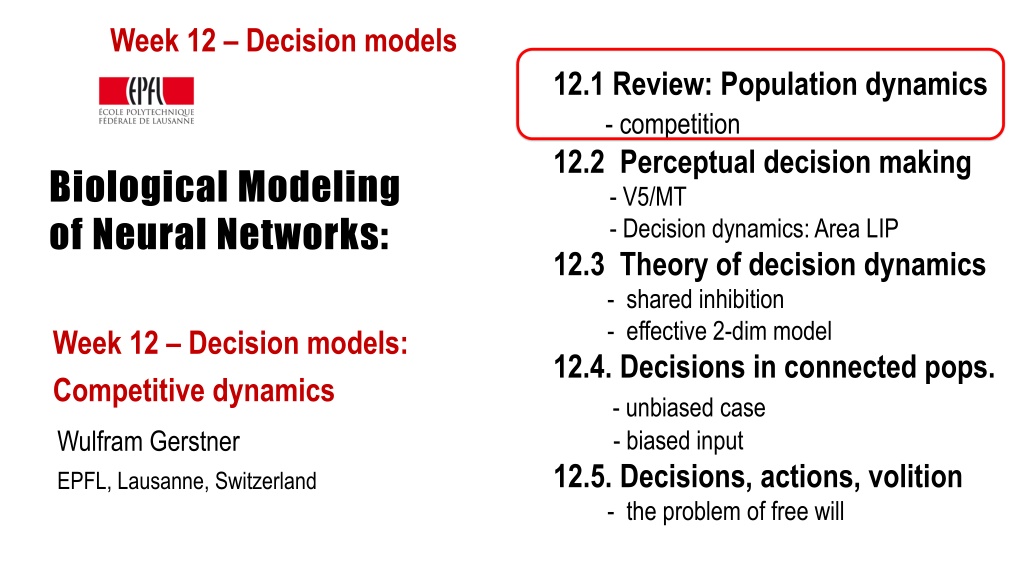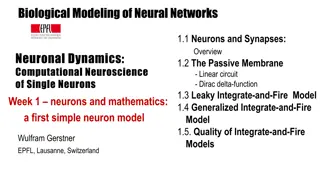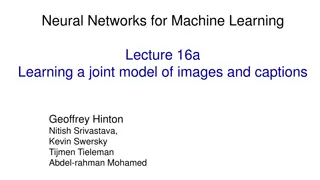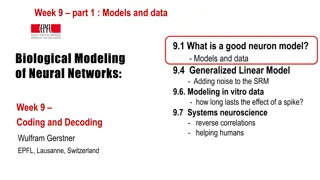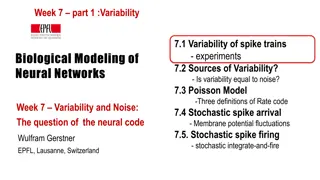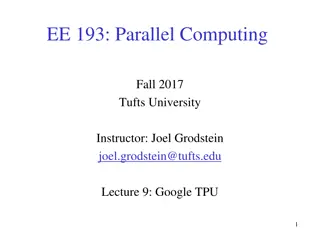Exploring Decision Models in Neural Networks: Population Dynamics, Perceptual Decision Making, and Theory
Dive into the world of decision models in neural networks with a focus on population dynamics and competition, perceptual decision making with V5/MT involvement, and the theory of decision dynamics including shared inhibition and effective 2-dim models.
Download Presentation

Please find below an Image/Link to download the presentation.
The content on the website is provided AS IS for your information and personal use only. It may not be sold, licensed, or shared on other websites without obtaining consent from the author. Download presentation by click this link. If you encounter any issues during the download, it is possible that the publisher has removed the file from their server.
E N D
Presentation Transcript
Week 12 Decision models 12.1 Review: Population dynamics - competition 12.2 Perceptual decision making - V5/MT - Decision dynamics: Area LIP 12.3 Theory of decision dynamics - shared inhibition - effective 2-dim model 12.4. Decisions in connected pops. - unbiased case - biased input 12.5. Decisions, actions, volition - the problem of free will Biological Modeling of Neural Networks: Week 12 Decision models: Competitive dynamics Wulfram Gerstner EPFL, Lausanne, Switzerland
Week 12-part 1: Decision making turn Left? Right?
Week 12-part 1: Review: High-noise activity equation noise model A (escape noise/fast noise) Population activity = ( ) ( ( )) F h t A t Membrane potential caused by input high noise = + d ( ) ( ) ( ) h t h t R I t dt = + + ext ( ) ( ) ( ) t ( ( )) d dth t h t R I w F h t ee w ee I(t) h(t) Attention: - valid for high noise only, else transients might be wrong - valid for high noise only, else spontaneous oscillations may arise slow transient ( ) A t = ( ( )) F h t
Week 12-part 1: Review: microscopic vs. macroscopic (t ) An I(t)
Week 12-part 1: Competition between two populations w w ee ee Input indicating right Input indicating left ( ) Ae 1 , t ( ) Ae t w , 2 ei w w ie ie (t ) Ainh
Week 12 Decision models 12.1 Review: Population dynamics - competition 12.2 Perceptual decision making - V5/MT - Decision dynamics: Area LIP 12.3 Theory of decision dynamics - shared inhibition - effective 2-dim model 12.4. Decisions in connected pops. - unbiased case - biased input 12.5. Decisions, actions, volition - the problem of free will Biological Modeling of Neural Networks: Week 12 Decision models: Competitive dynamics Wulfram Gerstner EPFL, Lausanne, Switzerland
Week 12-part 2: Perceptual decision making? Is the middle bar shifted to the left or to the right?
Week 12-part 2: Detour: receptive fields in V5/MT visual cortex IMAGE 1) Cells in visual cortex MT/V5 respond to motion stimuli 2) Neighboring cells in visual cortex MT/V5 respond to motion in similar direction cortical columns Albright, Desimone,Gross, J. Neurophysiol, 1985
Week 12-part 2: Detour: receptive fields in V5/MT Recordings from a single neuron in V5/MT Receptive Fields depend on direction of motion Random moving dot stimuli: e.g.Salzman, Britten, Newsome, 1990 Roitman and Shadlen, 2002 Gold and Shadlen 2007
Week 12-part 2: Detour: receptive fields in V5/MT Receptive Fields depend on direction of motion: = preferred direction = P
Week 12-part 2: Experiment of Salzmanet al. 1990 coherence 0.8=80% coherence 0.5 = 50% coherence 0.0 Eye movement coherence -1.0 opposite direction Image: Salzman, Britten, Newsome, 1990
Week 12-part 2: Experiment of Salzmanet al. 1990 Monkey behavior w. or w/o Stimulation of neurons in V5/MT Monkey chooses right N P fixation Visual stim. LED X = coherent motion to bottom right 1.0 -1.0 0.5 0.5 No bias, each point moves in random direction Blackboard: Motion detection/stimulation Salzman, Britten, Newsome, 1990
Week 12-part 2: Experiment of Salzmanet al. 1990 coherence 0.8=80% coherence 0.5 = 50% coherence 0.0 excites this group of neurons coherence -1.0
Week 12-part 2: Experiment of Salzmanet al. 1990 Behavior: psychophysics With stimulation
Week 12 Decision models 12.1 Review: Population dynamics - competition 12.2 Perceptual decision making - V5/MT - Decision dynamics: Area LIP 12.3 Theory of decision dynamics - shared inhibition - effective 2-dim model 12.4. Decisions in connected pops. - unbiased case - biased input 12.5. Decisions, actions, volition - the problem of free will Biological Modeling of Neural Networks: Week 12 Decision models: Competitive dynamics Wulfram Gerstner EPFL, Lausanne, Switzerland
Week 12-part 2: Experiment of Roitmanand Shadlenin LIP (2002) coherence 85% coherence 50% RF of Neuron in LIP: -selective to target of saccade -increases faster if signal is stronger - activity is noisy coherence 0% LIP is somewhere between MT (movement detection) and Frontal Eye Field (saccade control) Roitman and Shadlen 2002
Week 12-part 2: Experiment of Roitmanand Shadlenin LIP (2002) Neurons in LIP: -selective to target of saccade -increases faster if signal is stronger - activity is noisy LIP is somewhere between MT (movement detection) and Frontal Eye Field (saccade control)
Quiz 1, now Receptive field in LIP [ ] related to the target of a saccade [ ] depends on movement of random dots
Week 12 Decision models, part 3 12.1 Review: Population dynamics - competition 12.2 Perceptual decision making - V5/MT - Decision dynamics: Area LIP 12.3 Theory of decision dynamics - shared inhibition - effective 2-dim model 12.4. Decisions in connected pops. - unbiased case - biased input 12.5. Decisions, actions, volition - the problem of free will Biological Modeling of Neural Networks: Week 12 Decision models: Competitive dynamics Wulfram Gerstner EPFL, Lausanne, Switzerland
Week 12-part 3: Theory of decision dynamics = ( ) ( ( )) A t F h t activity equations n n Membrane potential caused by input ( ) h t = + + + ext ( ) ( ) t ( ( )) ( ( )) t d dth t RI w F h t w F h 1 1 1 1 ee ei inh = + + + ext ( ) ( ) ( ) t ( ( )) ( ( )) t d dth t h t RI w w F h t w F h 2 2 2 2 ee ei inh w ee ee Input indicating left movement Input indicating right movement ( ) Ae 1 , t ( ) Ae t w Blackboard: 2 , w ei ei population activity reduction from 3 to 2 equations w ie (t ) Ainh
Population activity activity equations = ( ) ( ( )) A t F h t n n = ( ) (0) (1) 0.2 0.8 F h F F h for h = = 0.1 0.9 Inhibitory Population = = = + ( ) t ( ( )) t ( ) t ( ( ) t ( )) t A F h h w A A ,1 ,2 inh inh inh ie e e Blackboard: Linearized inhibition
Week 12-part 3: Effective 2-dim. model = ( ) ( ( )) A t F h t activity equations n n Membrane potential caused by input ( ) ( ) h t = + + ) ( ( )) F h t ( ( )) F h t ext ( ) ( t d dth t h w 1 1 1 1 2 ee = + + ) ( ( )) F h t ( ( )) F h t ext ( ) ( ) ( ) ( t w d dth t h t h w 2 2 2 2 1 ee w ee ee Input indicating left movement Input indicating right movement ( ) Ae 1 , t ( ) Ae t 2 , w w ei ei population activity w ie (t ) Ainh
Exercise 1 now: draw nullclines and flow arrows ext = + + d ( ) ( ) ( ) ( ) ( ( )) ( ( )) h t h t h t w g h t g h t 1 1 1 1 2 ee dt = ( (0) (0.9) (1) ) 0.2 0.8 g h g g g h for h (h ) g = 0.1 = 0.85 0.9 h = 1.0 = ext ext = = ; 5 . 1 = ; 8 . 0 1 h h w 1 2 ee ( ) ( ) h g h h h g h h 1= h 2= h d d 0 0 1 2 2 2 1 1 dt dt 1.0 0.8 0.2 0.0 1.0 0.8 0.2 0.0 Next Lecture at 10:36
Week 12-part 3: Theory of decision dynamics Phase plane, strong external input 1= h d 0 dt = = ext ext 0.8 h h 1 2 = ( ) = 2 . 0 8 . 0 g h h for h ( 0 ) 1 . 0 g = ) 1 ( g 9 . 0 2= h d 0 dt
Week 12-part 3: Theory of decision dynamics: biased input Phase plane biased input: Population activity ext ext h h 2 1 1= h 0 d ext 0 1= h d 1= 1= d d0 = 0 dt h dt h 2 . 0 h 2 dt dt ext = 2 . 0 h 1 2= h d 0 dt ext = 2 . 0 h 2
Week 12-part 3: Theory of decision dynamics: unbiased weak Phase plane symmetric but small input 1= h d 0 ext 1 ext 2 = = 2 . 0 h h dt Weak external input: Stable fixed point 2= h d 0 dt
Week 12-part 3: decision dynamics: unbiased strong to biased Symmetric, but strong input 1= h d 0 dt Phase plane 2= h 2= h 2= h d d d 0 0 0 dt dt dt
Week 12-part 3: Theory of decision dynamics: biased strong Phase plane Population activity 1= h d 0 ext = ; 8 . 0 h dt 1 ext = 2 . 0 h 2 Biased input = stable fixed point decision reflects bias 2= h d 0 dt
Week 12-part 3: Theory of decision dynamics: unbiased strong Phase plane 1= h d 0 dt ext 1 ext 2 = = 8 . 0 h h Homogeneous solution = saddle point decision must be taken 2= h d 0 dt
Week 12 Decision models, part 3 12.1 Review: Population dynamics - competition 12.2 Perceptual decision making - V5/MT - Decision dynamics: Area LIP 12.3 Theory of decision dynamics - shared inhibition - effective 2-dim model 12.4. Decisions in connected pops. - unbiased case - biased input 12.5. Decisions, actions, volition - the problem of free will Biological Modeling of Neural Networks: Week 12 Decision models: Competitive dynamics Wulfram Gerstner EPFL, Lausanne, Switzerland
Week 12-part 4: Review: unbiased strong Phase plane 1= h d 0 dt ext 1 ext 2 = = 8 . 0 h h Homogeneous solution = saddle point decision must be taken 2= h d 0 dt
Week 12-4: Review: unbiased weak Phase plane symmetric but small input 1= h d 0 ext 1 ext 2 = = 2 . 0 h h dt Weak external input: Stable fixed point no decision 2= h d 0 dt
Simulation of 3 populations of spiking neurons, unbiased strong input X.J. Wang, 2002 NEURON Popul. 2 Popul.1 stimulus w ei w w ie ie
saccade onset Stimulus onset Roitman and Shadlen 2002
Week 12 Decision models, part 3 12.1 Review: Population dynamics - competition 12.2 Perceptual decision making - V5/MT - Decision dynamics: Area LIP 12.3 Theory of decision dynamics - shared inhibition - effective 2-dim model 12.4. Decisions in connected pops. - unbiased case - biased input 12.5. Decisions, actions, volition - the problem of free will Biological Modeling of Neural Networks: Week 12 Decision models: Competitive dynamics Wulfram Gerstner EPFL, Lausanne, Switzerland
Week 12-5: Decision: risky vs. safe How would you decide? goal
How would you decide? goal Start
fMRI variant of Libet experiment Decision and Movement Preparation -Subject decides spontaneously to move left or right hand - report when they made their decision Libet, Behav. Brain Sci., 1985 Soon et al., Nat. Neurosci., 2008
What decides? Who decides? Your brain decides what you want or what you prefer but your brain this is you!!! -Your experiences are memorized in your brain -Your values are memorized in your brain -Your decisions are reflected in brain activities We don t do what we want, but we want what we do (W. Prinz) The problem of Free Will (see e.g. Wikipedia article) goal goal Start
Decision, Perception and Competition in Connected Populations Wulfram Gerstner EPFL Suggested Reading: - Salzman et al. Nature 1990 - Roitman and Shadlen, J. Neurosci. 2002 - Abbott, Fusi, Miller: Theoretical Approaches to Neurosci. - X.-J. Wang, Neuron 2002 - Libet, Behav. Brain Sci., 1985 - Soon et al., Nat. Neurosci., 2008 - free will, Wikipedia Chapter 16, Neuronal Dynamics, Gerstner et al. Cambridge 2014
Last Lecture in 2 Weeks: (holiday next week) - prepare questions for discussion section Exam: - written exam 17. 06. 2013 from 12:15-15:00 - miniprojects counts 1/3 towards final grade For written exam: -bring 1 page A5 of own notes/summary -HANDWRITTEN! The end
Nearly the end: what can I improve for the students next year? Integrated exercises? Miniproject? Overall workload ?(4 credit course = 6hrs per week) Background/Prerequisites? -Physics students -SV students -Math students Comments: slides/notes
now QUESTION SESSION! Questions to Assistants possible until June 4 The end and good luck for the exam!
Exercise 2.1 now: stability of homogeneous solution )) ( ( ) ( t h g t A n n = Membrane potential caused by input ( ) ( ) ( ee h t b w = + + ) ( ( )) g h t g h t ( ( )) d dth t 1 1 1 2 = + + ) ( g h t ( ( )) g h t ( ) ( ) ( ( )) d dth t h t b w 2 2 2 1 ee ext 1 ext 2 = = Assume: h h b = = * ( ) h h h b a) Calculate homogeneous fixed point b) Analyze stability of the fixed point h(b) as a function of b 1 2 Next Lecture at 11:15
